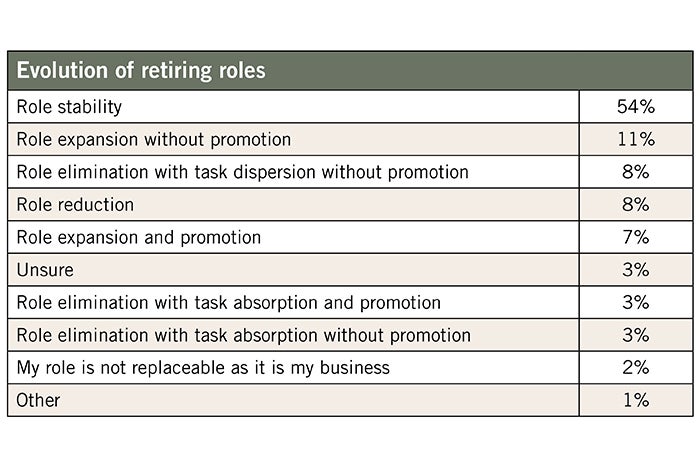Succession planning and financial decisions
Effective succession planning and workforce development are mission-critical, especially as the health care facilities profession prepares for the latest wave of retirements. The American Society for Health Care Engineering (ASHE) aims to provide ongoing insight into this topic by conducting applied research via a multi-step, data-supported approach. This column presents research collected through the most recent ASHE member survey and explores how organizational financial decision-making (e.g., restructuring and merging) should inform succession planning and facilities department staffing strategies.
Thirty-five percent of ASHE’s most recent member survey respondents plan to retire within the next five years. These 350 individuals (aka “projected retirees”) were asked to provide additional details about their current roles and responsibilities. The majority reported working at the director level (56%). However, projected retirees also reported working as managers (11%) or sole proprietors (11%). Furthermore, nearly a quarter of projected retirees worked within health care facilities engineering (21%), with other roles including facilities operations (17%), construction management (13%), plant operations management (11%) or health care facilities administration (10%).
In the simplest world, one would expect that organizations would need to replace the retiree’s position one-for-one, with the newly hired individual taking on the same exact title, compensation and responsibilities. However, given the ever-evolving nature of health care, it is important to understand how an organization’s structural and financial decisions (e.g., mergers, acquisitions and downsizing) might impact succession planning and hiring needs. Thus, we asked projected retirees to report their organization’s plans for their role after they retire. This information is important because it may better forecast the number of staff as well as the specific skill sets needed to maintain operations and safety.
Results indicated that the majority of respondents (54%) reported that their role would be replaced exactly as it currently is defined (“role stability”). Another 11% of respondents reported that their role would be expanded to include more responsibilities, direct reports or sites while remaining on-site and conducting the same duties they already perform without promotion (“role expansion without promotion”). An additional 7% of respondents reported that the role would be similarly expanded, but the new role would include a promotion (“role expansion and promotion”).
Conversely, 3% of respondents reported that their role would be eliminated, with role responsibilities divided among at least two other roles, but that none of these dispersed responsibility roles would receive a promotion (“role elimination with task dispersion without promotion”). Another 3% reported that their role responsibilities would be dispersed across more than one existing staff member, and that at least one of these members would receive a promotion for their expanded duties (“role elimination with task dispersion with promotion”).
These findings confirm other reports that show an increased need for director-level staff soon due to one-to-one role replacement. Interestingly, a significant number of retiring roles were also projected to be adapted in some way, with almost 20% of these roles projected to be expanded, with or without promotion. This points to the importance of mapping the revised role responsibilities to ensure the identification of candidates with the skills necessary to take on these expanded roles.
These findings underscore the importance of succession planning, particularly in situations where the organization has undergone restructuring or other business changes.
About this column
“Data Driven Insights” provides a primer on research basics and shares recent innovations and concrete answers by showcasing the collaborative applied research efforts of the American Society for Health Care Engineering members, academics and scientists and other related professionals working within complementary fields.





